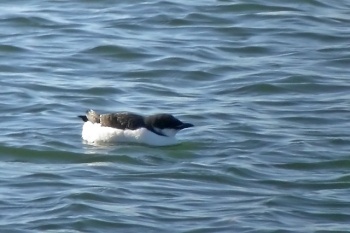m (→External Links) |
(→External Links: New combined GSearch. GSearch checked template. Video link deleted as no longer available) |
||
| (12 intermediate revisions by 3 users not shown) | |||
| Line 1: | Line 1: | ||
| − | |||
| − | |||
'''Alternative name: Brunnich's Guillemot''' | '''Alternative name: Brunnich's Guillemot''' | ||
| + | [[Image:Thick-billed_Murre.jpg|thumb|550px|right|Photo by {{user|Sungrebe|Sungrebe}}<br />St Paul Island, [[Alaska]], July 2004]] | ||
| + | |||
;[[:Category:Uria|Uria]] lomvia | ;[[:Category:Uria|Uria]] lomvia | ||
==Identification== | ==Identification== | ||
| − | 40- | + | 40-44 cm (15¾-17¼ in) |
| + | *Black head, neck, back and wings | ||
| + | *White underparts | ||
| + | *Long and pointed bill | ||
| + | *Small rounded black tail<br /> | ||
| + | [[Image:Brunnichs Guillemot.jpg|thumb|350px|right|<br />Photo by {{user|NIGHTJAR1|NIGHTJAR1}}<br />Spitzbergen, [[Norway]], June 2007]] | ||
| + | '''Non-breeding''': face shows more white | ||
==Distribution== | ==Distribution== | ||
| − | + | Arctic areas of [[Europe]], [[Asia]] and [[North America]]:<br /> | |
| + | '''North America''': [[Canada]], [[Newfoundland]], [[Nova Scotia]], [[New England]], [[Alaska]], [[Aleutian Islands]]<br /> | ||
| + | '''Europe''': [[Iceland]], [[Scandinavia]], [[Norway]], [[Finland]], [[Faroe Islands]], [[Greenland]], [[Baltic States|Baltic]]<br /> | ||
| + | '''Asia''': [[Russia]], [[Siberia]], [[Japan]] | ||
==Taxonomy== | ==Taxonomy== | ||
| − | + | ====Subspecies==== | |
| + | There are 4 subspecies<sup>[[#References|[1]]]</sup>: | ||
| + | *''U. l. lomvia'': | ||
| + | :*Gulf of St. Lawrence to [[Greenland]] and Novaya Zemlya | ||
| + | *''U. l. eleonorae'': | ||
| + | :*Eastern Taymyr Peninsula to New Siberian Islands ([[Russia]]) | ||
| + | *''U. l. heckeri'': | ||
| + | :*Wrangel Island, Herald Island and northern Chukotsk Peninsula | ||
| + | *''U. l. arra'': | ||
| + | :*Northern [[Japan]] and [[Aleutian Islands]] to south-eastern [[Alaska]] | ||
| + | '''Alternative name: Brunnich's Guillemot''' | ||
| + | [[Image:1461DSCN5795web-sm.jpg|thumb|350px|right|Winter plumage<br />Photo by {{user|rb_stern|rb_stern}}<br />Lunenburg, NS, [[Canada]], February 2005 ]] | ||
==Habitat== | ==Habitat== | ||
| − | + | Pelagic. Breeds on rocky seaside cliffs. | |
==Behaviour== | ==Behaviour== | ||
| − | + | ====Breeding==== | |
| + | Colonial breeders on cliff edges. The lay a single egg. | ||
| + | ====Diet==== | ||
| + | They find their food underwater, in deep dives. The diet includes invertebrates and occasionally fish; the chicks are fed fish, squid, crustaceans and other small invertebrates. | ||
| + | ====Vocalisation==== | ||
| + | {{ Audio|Uria lomvia (song).mp3 }} | ||
| − | + | ==References== | |
| − | + | #{{Ref-Clements6thAug17}}#Avibase | |
| − | + | #Wikipedia | |
| − | + | {{ref}} | |
==External Links== | ==External Links== | ||
| − | {{GSearch|Uria | + | {{GSearch|"Uria lomvia" {{!}} "Thick-billed Murre" {{!}} "Brunnich Guillemot"}} |
| + | {{GS-checked}}1 | ||
<br /> | <br /> | ||
| − | + | <br /> | |
| − | + | ||
| − | |||
[[Category:Birds]] [[Category:Bird Songs]] [[Category:Uria]] | [[Category:Birds]] [[Category:Bird Songs]] [[Category:Uria]] | ||
Latest revision as of 23:49, 8 February 2023
Alternative name: Brunnich's Guillemot
- Uria lomvia
Identification
40-44 cm (15¾-17¼ in)
- Black head, neck, back and wings
- White underparts
- Long and pointed bill
- Small rounded black tail
Non-breeding: face shows more white
Distribution
Arctic areas of Europe, Asia and North America:
North America: Canada, Newfoundland, Nova Scotia, New England, Alaska, Aleutian Islands
Europe: Iceland, Scandinavia, Norway, Finland, Faroe Islands, Greenland, Baltic
Asia: Russia, Siberia, Japan
Taxonomy
Subspecies
There are 4 subspecies[1]:
- U. l. lomvia:
- Gulf of St. Lawrence to Greenland and Novaya Zemlya
- U. l. eleonorae:
- Eastern Taymyr Peninsula to New Siberian Islands (Russia)
- U. l. heckeri:
- Wrangel Island, Herald Island and northern Chukotsk Peninsula
- U. l. arra:
- Northern Japan and Aleutian Islands to south-eastern Alaska
Alternative name: Brunnich's Guillemot
Habitat
Pelagic. Breeds on rocky seaside cliffs.
Behaviour
Breeding
Colonial breeders on cliff edges. The lay a single egg.
Diet
They find their food underwater, in deep dives. The diet includes invertebrates and occasionally fish; the chicks are fed fish, squid, crustaceans and other small invertebrates.
Vocalisation
References
- Clements, J. F., T. S. Schulenberg, M. J. Iliff, D. Roberson, T. A. Fredericks, B. L. Sullivan, and C. L. Wood. 2017. The eBird/Clements checklist of birds of the world: v2017, with updates to August 2017. Downloaded from http://www.birds.cornell.edu/clementschecklist/download/
- Avibase
- Wikipedia
Recommended Citation
- BirdForum Opus contributors. (2024) Thick-billed Murre. In: BirdForum, the forum for wild birds and birding. Retrieved 22 December 2024 from https://www.birdforum.net/opus/Thick-billed_Murre
External Links
GSearch checked for 2020 platform.1






